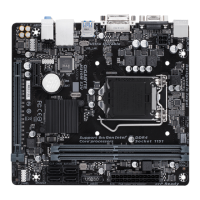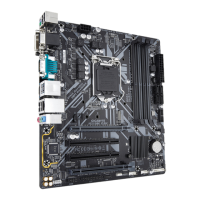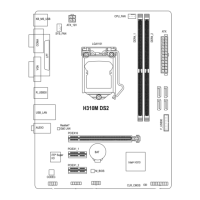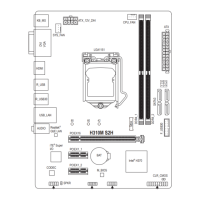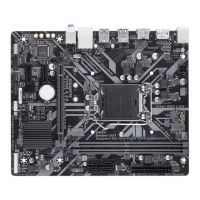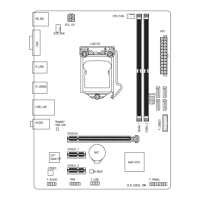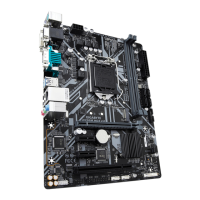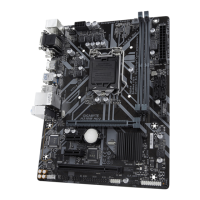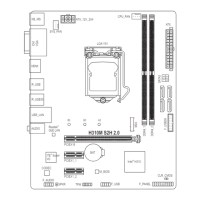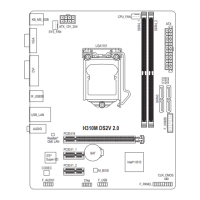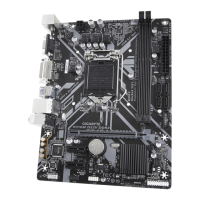Do you have a question about the Gigabyte H310N and is the answer not in the manual?
Safety guidelines for installing motherboard components to prevent damage.
Details on CPU, Memory, Graphics, Audio, LAN, Storage, USB, and Expansion Slots.
Step-by-step guide for safely installing the CPU onto the motherboard socket.
Instructions for installing RAM modules and dual-channel configuration.
Guidance on correctly installing expansion cards into PCI Express slots.
Description of ports and connectors located on the rear of the motherboard.
Identification and pinouts for internal motherboard connectors.
Overview of the initial screen displayed during the computer's boot process.
Explanation of the main BIOS interface, including navigation and function keys.
Advanced settings for CPU, memory, and system tuning for performance.
Information about motherboard model, BIOS version, and system date/time settings.
Configuration options for boot order, system security, and advanced boot features.
Settings for onboard devices like LAN, audio, USB, and storage controllers.
Configuration options related to the motherboard's chipset, including graphics and audio.
Settings for power management, wake-up events, and AC power loss behavior.
Options for saving BIOS changes, loading defaults, or exiting the setup utility.
Instructions on how to install necessary drivers for the motherboard components.
Information on environmental compliance, RoHS, WEEE, and FCC/IC notices.
Safety guidelines for installing motherboard components to prevent damage.
Details on CPU, Memory, Graphics, Audio, LAN, Storage, USB, and Expansion Slots.
Step-by-step guide for safely installing the CPU onto the motherboard socket.
Instructions for installing RAM modules and dual-channel configuration.
Guidance on correctly installing expansion cards into PCI Express slots.
Description of ports and connectors located on the rear of the motherboard.
Identification and pinouts for internal motherboard connectors.
Overview of the initial screen displayed during the computer's boot process.
Explanation of the main BIOS interface, including navigation and function keys.
Advanced settings for CPU, memory, and system tuning for performance.
Information about motherboard model, BIOS version, and system date/time settings.
Configuration options for boot order, system security, and advanced boot features.
Settings for onboard devices like LAN, audio, USB, and storage controllers.
Configuration options related to the motherboard's chipset, including graphics and audio.
Settings for power management, wake-up events, and AC power loss behavior.
Options for saving BIOS changes, loading defaults, or exiting the setup utility.
Instructions on how to install necessary drivers for the motherboard components.
Information on environmental compliance, RoHS, WEEE, and FCC/IC notices.
| Memory channels | Dual-channel |
|---|---|
| Memory slots type | DIMM |
| Unbuffered memory | Yes |
| Number of memory slots | 2 |
| Supported memory types | DDR4-SDRAM |
| Maximum internal memory | 32 GB |
| Supported memory clock speeds | 2133, 2400, 2666 MHz |
| Processor socket | LGA 1151 (Socket H4) |
| Processor manufacturer | Intel |
| Compatible processor series | Intel Core i3, Intel Core i5, Intel Core i7, Intel Pentium |
| HDMI version | 1.4 |
| USB 2.0 ports quantity | USB 2.0 ports have a data transmission speed of 480 Mbps, and are backwards compatible with USB 1.1 ports. You can connect all kinds of peripheral devices to them. |
| USB 3.2 Gen 2 (3.1 Gen 2) Type-C ports quantity | 0 |
| Audio chip | Realtek ALC887 |
| Component for | PC |
| Motherboard chipset | Intel® H310 |
| PC health monitoring | FAN, Temperature, Voltage |
| Audio output channels | 7.1 channels |
| Motherboard form factor | mini ITX |
| Windows operating systems supported | Windows 10 Education x64, Windows 10 Enterprise x64, Windows 10 Home x64, Windows 10 Pro x64 |
| Ethernet interface type | Gigabit Ethernet |
| Number of SATA III connectors | 4 |
| BIOS type | UEFI AMI |
| ACPI version | 5.0 |
| BIOS memory size | 128 Mbit |
| Desktop Management Interface (DMI) version | 2.7 |
| Cables included | SATA |
| Bundled software | Norton Internet Security |
| Width | 170 mm |
|---|
